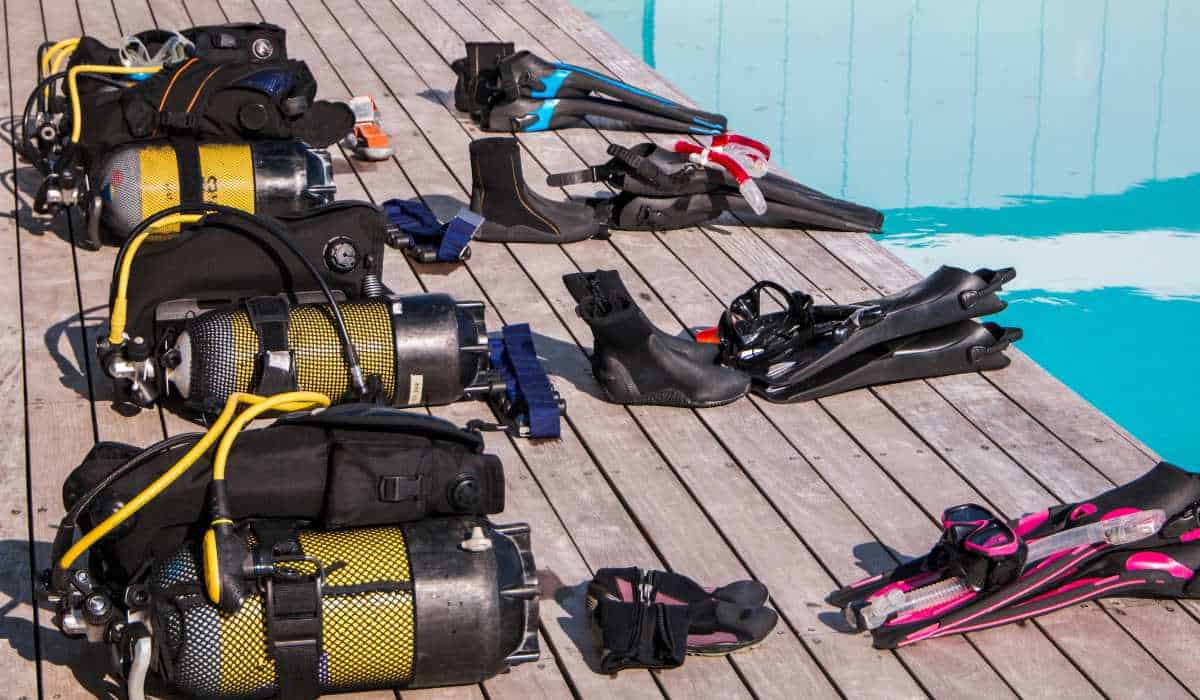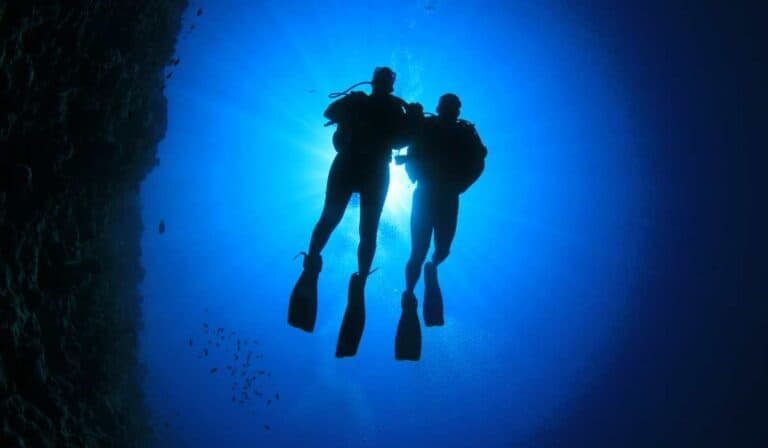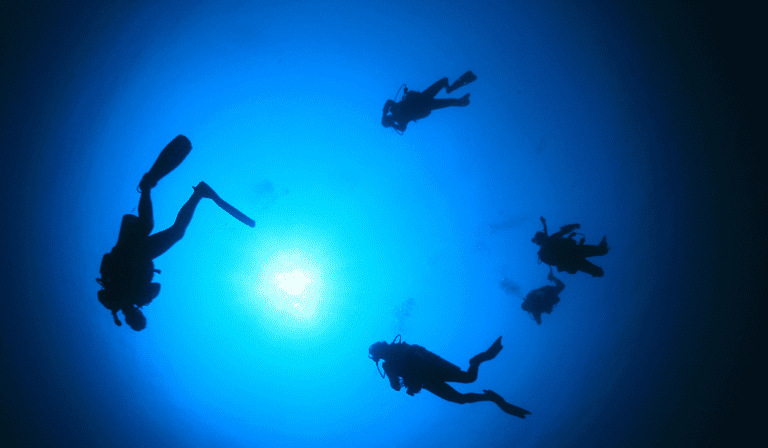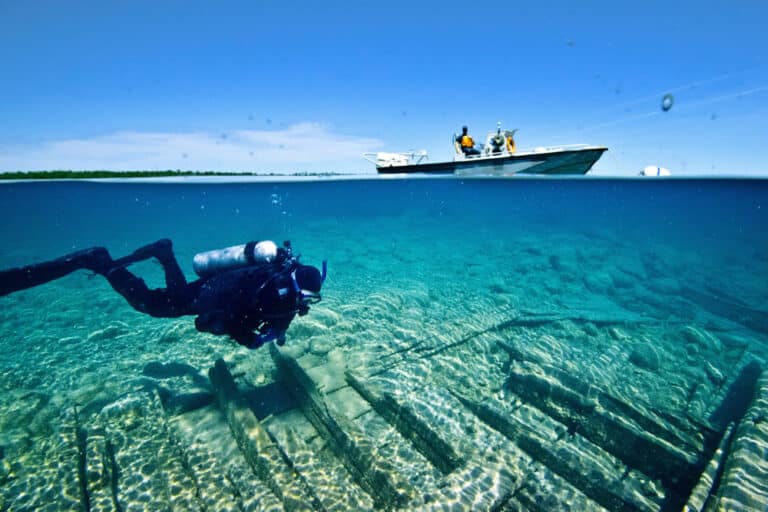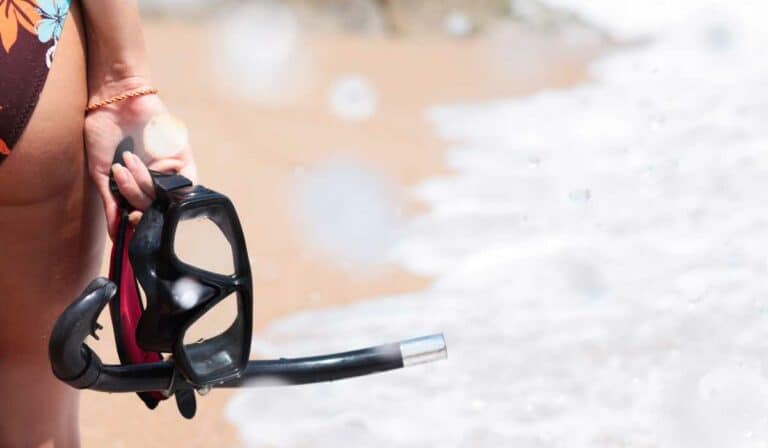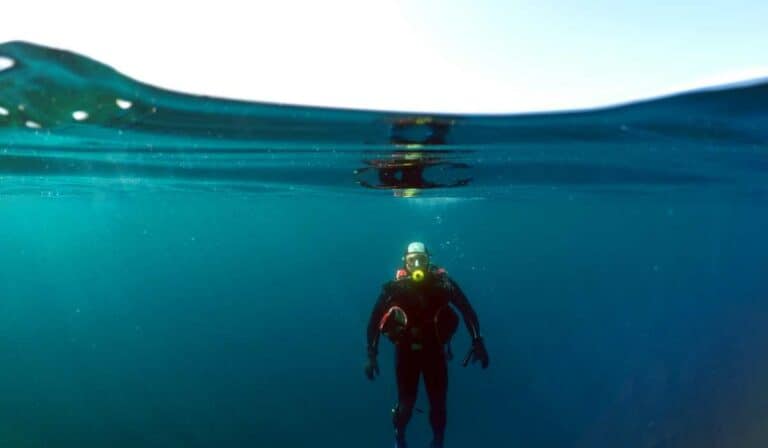Ultimate Guide to Scuba Diving Gear
Welcome to our comprehensive resource for scuba diving gear – here, we’ll provide you with all the knowledge and advice needed to pick out the best equipment. Whether you’re a beginner or an experienced diver, this guide has something for everyone.
In this comprehensive guide, we will cover everything from choosing the right clothing for scuba diving, such as wet suits and dry suits, to understanding the benefits and drawbacks of each type. We’ll also delve into essential knives for scuba diving that can come in handy during your underwater adventures.
Furthermore, our ultimate guide will discuss various pieces of essential scuba diving gear like masks, snorkels, fins, and more. You’ll learn how to select the perfect mask that provides optimal comfort and visibility while exploring the underwater world. Additionally, we’ll share valuable tips on selecting snorkels & fins that best suit your needs.
“The Ultimate Guide To Scuba Diving Gear” is designed not only to help you make smart equipment choices but also to enhance your overall experience beneath the waves. So dive in with us as we explore everything there is to know about scuba gear!
Table of Contents
1. Choosing the Right Clothing for Scuba Diving
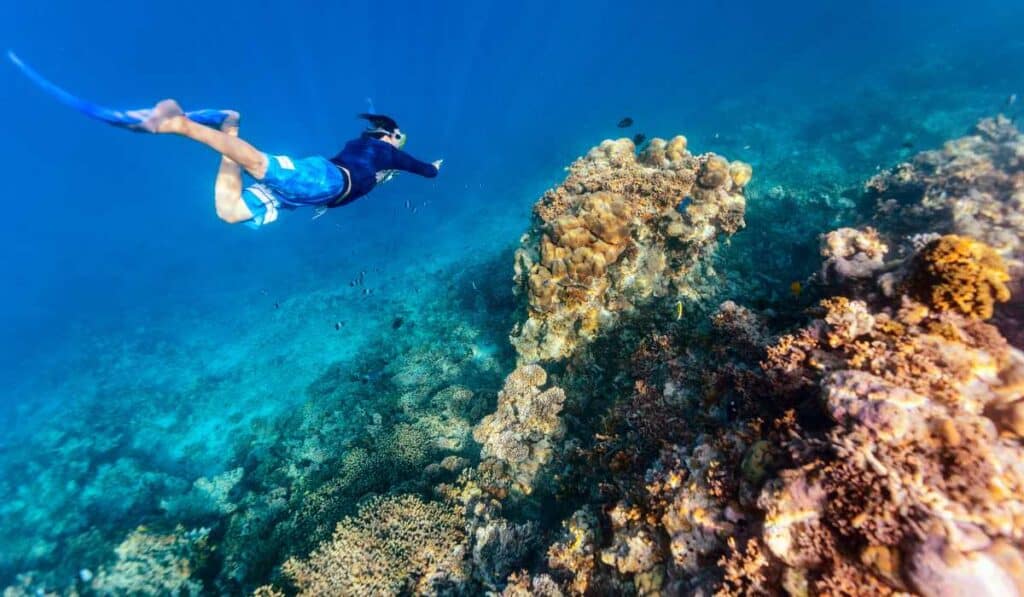
When selecting clothing for scuba diving, comfort and safety must be taken into consideration; thus, it is important to pick the right attire. Different garments designed to meet different needs and preferences are available for scuba diving. Having established the importance of wearing appropriate clothing for scuba diving, we will now provide guidance on how to select the right option based on individual needs.
A. Rash Guards & Dive Skins
Rash guards and dive skins are lightweight options that offer protection from sunburn, chafing, and minor scrapes while underwater. They also provide a minimal amount of thermal insulation in warm water conditions but should not be relied upon as primary exposure protection in colder waters.
- Rash guards: Made from stretchy materials like spandex or Lycra; typically worn as tight-fitting shirts or shorts.
- Dive skins: Full-body suits made from similar materials as rash guards; ideal for those who prefer more coverage than what a rash guard provides.
B. Wetsuits & Drysuits
In cooler water temperatures or when engaging in deeper dives, you’ll need more substantial exposure protection such as wetsuits or drysuits:
- Wetsuit: A neoprene suit that insulates by trapping a thin layer of water between your body and the suit itself which warms up due to body heat (more details provided below).
- Drysuit: A waterproof suit with seals at wrists, neck, and ankles that keeps you completely dry inside (more details provided below).
C. Accessories
Additional clothing accessories can further enhance your scuba diving experience:
- Boots: Neoprene dive boots provide thermal protection for your feet and help prevent cuts or scrapes when walking on rocky surfaces.
- Gloves: Dive gloves offer hand protection from cold water temperatures, as well as potential hazards like sharp rocks or marine life.
- Hoods: Neoprene hoods are essential in colder waters to retain heat around the head and protect ears from pressure changes during descent.
When scuba diving, factors such as water temp., comfort level, and dive type should be taken into account when selecting the correct clothing. For example, if you’re diving in tropical waters with minimal exposure risks, a rash guard may suffice; however, if exploring colder environments or engaging in technical dives requiring additional gear management skills – investing in a wetsuit or drysuit would be more appropriate.
When selecting attire for scuba diving, comfort and safety should be paramount considerations. Wet suits are designed to provide thermal protection while allowing maximum flexibility in movement, so make sure you select a suit that fits properly.
Key Takeaway:
This section provides a comprehensive guide to choosing the right clothing for scuba diving, including rash guards and dive skins for warm water conditions, wetsuits and drysuits for colder waters or deeper dives, and accessories like boots, gloves, and hoods. It emphasizes the importance of considering factors such as water temperature and personal comfort preferences when selecting appropriate gear.
Click here to read about World’s Best Quarries for Scuba Diving
2. Wet Suits: What You Need to Know
Venturing into the realm of scuba diving necessitates familiarizing oneself with wet suits, which are a must for preserving body heat and guaranteeing a pleasant dive. In this article, we will look at the various wet suit options available and how to choose the right one for your dive needs.
A. Types of Wet Suits
Wet suits come in various styles designed for specific water temperatures and activities. Here are some common types:
- Full Suit: Covers your entire body from wrists to ankles; ideal for colder waters.
- Shorty: Features short sleeves and legs; suitable for warmer waters or surface water sports like snorkeling.
- Farmer John/Jane: Sleeveless design with full-length legs; can be worn alone or layered under a jacket for added warmth.
- Springsuit: Combines long sleeves with short legs; perfect for mild water temperatures or transitional seasons.
B. Thickness & Material
The thickness of a wet suit is measured in millimeters (mm) and determines its insulating properties – thicker wetsuits provide better insulation against cold water temperatures. The thickness of wetsuits usually ranges from 3mm to 7mm, with thicker suits providing more insulation. Here’s an informative guide on choosing the right wetsuit thickness based on water temperature.
In addition to thickness, consider the material used in constructing the wet suit: Neoprene is the most common material, providing excellent insulation and flexibility. Some manufacturers also offer eco-friendly alternatives made from natural or recycled materials.
C. Fit & Sizing
A well-fitting wet suit should be snug but not restrictive, allowing for a full range of motion while diving. To find your perfect fit:
- Consult the manufacturer’s size chart and measure yourself accurately.
- Try on multiple sizes to ensure proper fit – remember that different brands may have slightly different sizing standards.
- If possible, visit a local dive shop where you can try on various suits and get expert advice on fitting.
D. Features to Consider
Beyond type, thickness, and fit, there are additional features to consider when selecting a wet suit:
- Zippers: Choose between back zippers (easier entry/exit) or chest zippers (better water sealing).
- Knee Pads: Reinforced knee pads provide extra durability in high-wear areas.
- Hoods & Gloves: For colder waters or extended dives, integrated hoods/gloves add warmth without sacrificing mobility.
Wet suits are essential for scuba diving and selecting the right one requires knowledge of different types, fabrics, and features. Moving on from there, dry suits provide many benefits for divers but also come with some drawbacks that must be taken into consideration before investing in one.
Key Takeaway:
This article is the ultimate guide to scuba diving gear, specifically focusing on wet suits. It covers different types of wet suits for various water temperatures and activities, how to choose the right thickness and material, tips for finding the perfect fit, and additional features like zippers, knee pads, hoods & gloves.
3. Dry Suits: The Benefits and Drawbacks
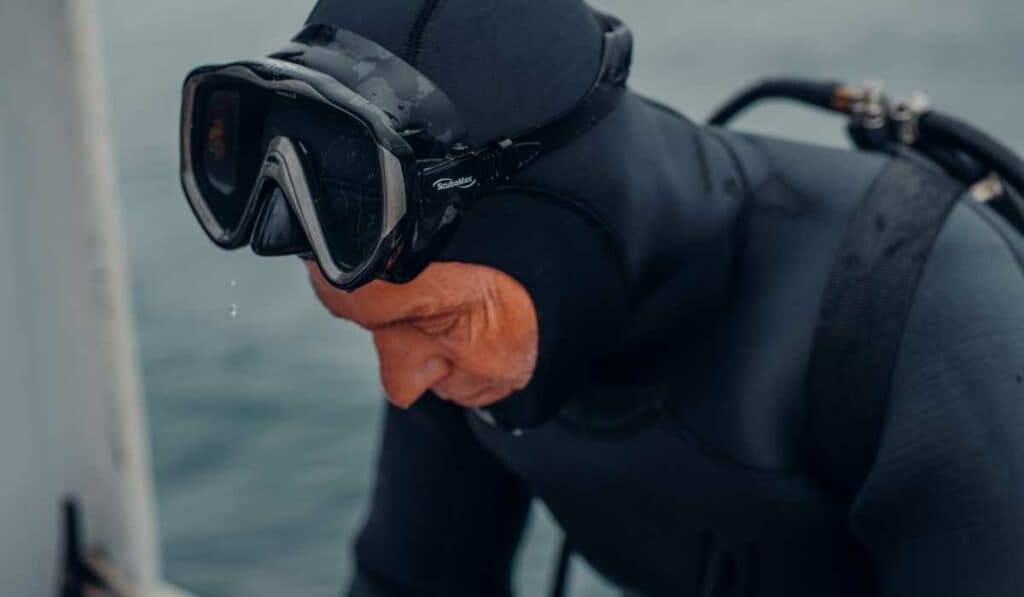
Dry suits are an alternative to wet suits, offering a different set of advantages and disadvantages for scuba divers. In this section, we will discuss the benefits and drawbacks of using dry suits while diving.
The Advantages of Dry Suits
- Thermal Protection: One of the main reasons divers choose dry suits is because they provide excellent thermal protection. A dry suit seals out water completely, allowing you to wear insulating layers underneath it. This makes them ideal for cold-water dives or long-duration dives where staying warm is crucial.
- Buoyancy Control: Since a dry suit contains air pockets that can be adjusted by adding or releasing air during your dive, it offers better buoyancy control compared to wet suits.
- Versatility: Due to their ability to accommodate various types of insulation layers beneath them, dry suits offer more versatility in terms of adapting to different water temperatures and environments.
The Disadvantages of Dry Suits
- Cost: One major drawback with dry suits is their cost; they tend to be significantly more expensive than wet suits. However, if you plan on diving frequently in colder waters or want the added comfort provided by a dry suit’s features, investing in one may be worth it in the long run.
- Maintenance & Care: Dry suits require more maintenance than wet suits due to their complex sealing systems and materials used. Regular checks for leaks, proper storage, and cleaning are essential to ensure the longevity of your dry suit.
- Learning Curve: Using a dry suit requires additional training and practice in buoyancy control compared to using a wet suit. It may take some time for new divers to get used to managing their buoyancy with a dry suit.
Click here to read about Best Watches for Scuba Diving: Time to Dive In
In summary, choosing between a wet suit or dry suit depends on factors such as water temperature, dive duration, personal preference, and budget. If you’re diving in colder waters or require better thermal protection and buoyancy control, investing in a quality dry suit might be the right choice for you. However, if cost is an issue or you primarily dive in warmer waters where thermal protection isn’t as crucial, sticking with a wet suit may be more suitable.
Though dry suits offer the benefit of warmth and dryness while diving, potential drawbacks should be taken into account before committing to a purchase. As we move on to our next topic of essential knives for scuba diving, it’s important to remember the safety precautions associated with bringing sharp objects underwater.
Key Takeaway:
This section discusses the benefits and drawbacks of using dry suits for scuba diving. Dry suits offer excellent thermal protection, better buoyancy control, and versatility in adapting to different water temperatures and environments. However, they tend to be more expensive than wet suits, require more maintenance and care, and have a learning curve for managing buoyancy.
4. Essential Knives for Scuba Diving
For scuba diving, a good knife can greatly improve the experience and safety of a dive. A reliable dive knife is an essential tool that serves various purposes, such as cutting entangled lines or nets, prying objects loose, signaling your dive buddy with its metallic sound against the tank, and even protecting yourself from potential underwater threats.
A. Types of Dive Knives
There are several types of knives available on the market designed specifically for scuba diving:
- Fixed Blade: These knives have a fixed blade and usually come with a sheath for secure storage when not in use. They tend to be more robust and versatile than folding knives but may require extra care to avoid accidental injuries.
- Folding Knife: Folding knives are compact and easy to carry around since their blades fold into the handle when not in use. However, they might not be as durable or versatile as fixed-blade options.
- Serrated Edge vs Straight Edge: Serrated edge blades work best for cutting through ropes or fishing lines while straight-edge blades excel at slicing materials like kelp or plastic bags smoothly.
- Titanium vs Stainless Steel Blades: Titanium blades offer excellent corrosion resistance but can be more expensive than stainless steel options which also provide good durability if properly maintained.
B. Choosing the Right Dive Knife
To select the perfect dive knife suited for your needs, consider these factors before making a purchase decision:
- Purpose of Use: Determine what you will primarily use the knife for, such as cutting lines or signaling your dive buddy. Determining the kind and magnitude of blade can be aided by assessing what it will mainly be employed for, such as snipping cords or alerting your dive partner.
- Size & Weight: Choose a knife that is comfortable to carry and easy to handle underwater. A compact and lightweight option might be more suitable if you have limited space in your gear setup.
- Attachment Options: Look for knives with multiple attachment points, allowing you to secure them conveniently on your BCD or other equipment without hindering accessibility during dives.
In addition to these factors, it’s essential to research reputable brands known for producing high-quality diving knives like Cressi, TUSA, or Aqua Lung. Reading customer reviews and seeking advice from experienced divers can also help narrow down your options further.
C. Dive Knife Maintenance & Safety Tips
To ensure the longevity of your dive knife and maintain its functionality, follow these maintenance tips:
- Rinse thoroughly with fresh water after each dive session to remove saltwater residue which may cause corrosion over time.
- Dry completely before storing it away in its sheath or case – moisture trapped inside could lead to rust formation on metal parts.
- If necessary, sharpen blades regularly using a dedicated sharpener designed specifically for scuba diving knives’ unique edge types (serrated/straight).
Above all else, remember always practice safety when handling any type of knife – whether on land or underwater. Keep your dive knife secured in its sheath when not in use, and exercise caution while using it to avoid accidental injuries.
Having the right knife for scuba diving is essential to ensure safety and enjoyment during your dives. Next, it’s essential to recognize what gear is required when getting ready for a plunge.
Key Takeaway:
Having the right dive knife is crucial for scuba diving as it can serve various purposes such as cutting entangled lines, prying objects loose, and protecting oneself from potential underwater threats. When choosing a dive knife, consider factors like purpose of use, size & weight, and attachment options; also maintain your knife by rinsing thoroughly with fresh water after each session to remove saltwater residue which may cause corrosion over time.
Click here to read about Jamaica Scuba Diving Guide: Dive into the Best Underwater World
5. Essential Scuba Diving Equipment
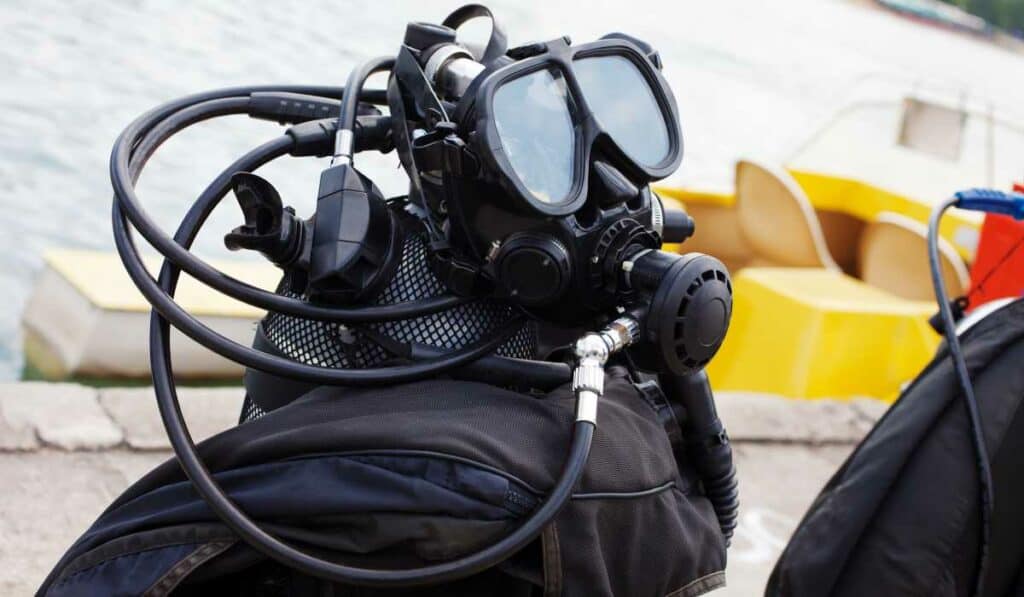
When it comes to scuba diving, having the right equipment is crucial for a safe and enjoyable experience. To ensure a safe and enjoyable dive, we’ll explore the essential scuba diving gear required for your underwater journey.
A. Regulators: Your Underwater Lifeline
The regulator is arguably the most important piece of scuba diving equipment as it allows you to breathe underwater by regulating air pressure from your tank. There are two main components to a regulator: the first stage connects directly to your tank while the second stage goes into your mouth.
- First Stage: This component reduces high-pressure air from your tank down to an intermediate pressure suitable for breathing.
- Second Stage: The part that goes in your mouth further reduces air pressure and delivers breathable air on demand when you inhale.
B. Tanks: Storing Your Air Supply
Your dive wouldn’t be possible without an adequate supply of compressed air stored in a sturdy, reliable scuba tank. These tanks come in various sizes and materials like aluminum or steel, each with its own advantages depending on factors such as depth and duration of dives.
C. Gauges & Computers: Monitoring Vital Information
To ensure safety during dives, divers must keep track of critical information such as depth, time spent underwater, remaining air supply, and more using gauges or dive computers. Dive computers are a popular choice as they provide all this information in one compact device, often with additional features like dive planning and logging capabilities.
D. Buoyancy Control Device (BCD): Staying Afloat
A Buoyancy Control Device (BCD) is essential for maintaining neutral buoyancy underwater and staying at your desired depth without constantly kicking or swimming. BCDs come in various styles such as jacket-style, back-inflate, or wing-style depending on personal preference and diving needs.
E. Weight System: Achieving Neutral Buoyancy
To counteract the natural buoyancy of your body and gear, you’ll need to wear weights while diving. These can be added through integrated weight systems built into your BCD or by using separate weight belts.
F. Exposure Protection: Staying Warm & Safe
Depending on water temperature and conditions, divers may require exposure protection such as wetsuits or dry suits (discussed earlier). Other protective gear includes gloves, boots, hoods, and rash guards to keep you safe from cuts, scrapes, or stings during dives.
In addition to these essentials mentioned above, there are many other pieces of scuba diving equipment that can enhance your experience – including underwater cameras for capturing memories of the amazing marine life you encounter. Remember always to invest in quality gear from reputable brands for safety reasons – happy diving.
Having the right scuba diving equipment is essential for a safe and enjoyable dive. Next, let’s explore how to choose the ideal face covering for your next aquatic journey.
Key Takeaway:
The ultimate guide to scuba diving gear highlights the essential equipment required for a safe and enjoyable underwater experience. The article covers regulators, tanks, gauges & computers, BCDs, weight systems, and exposure protection as key components of scuba diving gear that every diver must have in their arsenal. It also emphasizes investing in quality gear from reputable brands for safety reasons.
6. Masks: Selecting the Right One
Picking the ideal mask for your scuba diving journey is essential, as it enables you to observe clearly underwater and ensures a pleasant fit during your plunge. To make sure your dive is comfortable and you can see clearly underwater, it’s essential to select the right mask for your scuba diving adventure.
A. Types of Scuba Diving Masks
There are several types of scuba diving masks available in the market, each with its own unique features:
- Single Lens Mask: This type has one large lens that provides an unobstructed view while underwater.
- Dual Lens Mask: These masks have two separate lenses, which can be helpful if you need prescription lenses or prefer a more customized fit.
- Full Face Mask: A full face mask covers both your eyes and mouth, allowing you to breathe through either a regulator or snorkel without needing a separate mouthpiece. They also offer increased visibility due to their wide field of view.
- Framed vs Frameless Masks: Framed masks have a rigid frame around the lens(es), providing additional support and durability. Frameless masks eliminate this frame for reduced weight and increased comfort but may be less durable over time.
B. Factors To Consider When Choosing Your Scuba Diving Mask
To select the best mask suited for your dive experience, consider these factors before making a purchase decision:
- Fitting & Comfortability: The most important factor when choosing any piece of gear is ensuring it fits comfortably on your face without causing any discomfort or pain. Try on different masks to find the one that provides a secure seal around your face without being too tight.
- Visibility: Select a mask that offers clear and wide visibility underwater, allowing you to fully enjoy your diving experience. Consider lens materials like tempered glass for better clarity and durability.
- Prescription Lenses: If you wear glasses or contact lenses, consider choosing a dual-lens mask with prescription lenses installed by an optician or dive shop specialist.
- Ease of Adjustment: A good scuba diving mask should have easily adjustable straps to ensure it stays in place throughout your dive. Look for features such as quick-release buckles for added convenience.
To learn more about selecting the right scuba diving mask, check out this comprehensive guide from Scuba Diving Magazine.
Selecting the appropriate mask is paramount for a secure, pleasurable dive experience; it is an indispensable element of scuba diving equipment. Having taken the importance of masks into account, it is now prudent to focus on snorkels and fins for a successful scuba diving experience.
Key Takeaway:
Selecting an apt scuba diving mask is essential for a pleasurable and safe underwater excursion. Factors to consider include fitting, visibility, prescription lenses (if needed), and ease of adjustment. Different types of masks are available such as single lens, dual lens, full face mask, and framed vs frameless masks.
Click here to read about Best Spots for Scuba Diving in the Caribbean
7. Snorkels & Fins: What You Need To Know
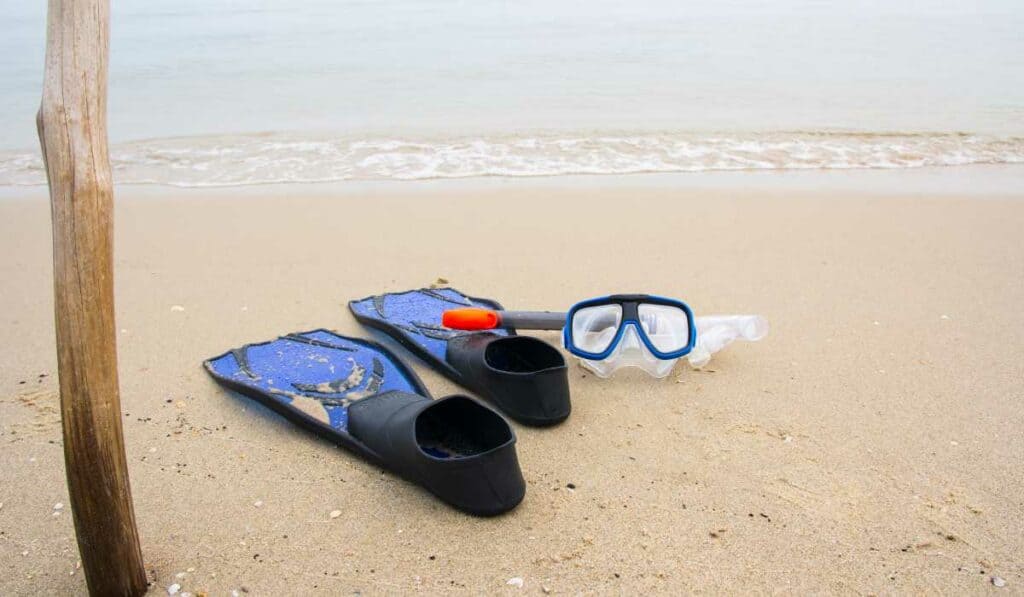
In this section, we’ll discuss the features of these essential pieces of dive gear and provide tips on selecting the best options for your needs.
A. Choosing the Right Snorkel
Breathing at the water’s surface without needing to raise your head can be achieved through snorkels, which helps save energy pre- and post-dive. When choosing a snorkel, consider factors such as comfort, ease of use, and durability:
- Mouthpiece: Look for a comfortable silicone mouthpiece that fits well in your mouth without causing discomfort or fatigue.
- Purge Valve: A purge valve makes it easier to clear water from your snorkel by allowing you to blow air through one end while keeping water out.
- Dry Top: This feature prevents water from entering your snorkel when submerged or during choppy conditions at the surface.
B. Selecting Suitable Fins
Fins are crucial for efficient fin kicking and maneuverability underwater. They come in various styles and materials designed for different types of dives and personal preferences:
- Open-Heeled vs Full-Footed Fins: An open-heeled design allows you to wear booties with adjustable straps providing better fitment flexibility whereas full-footed fins have no straps and are worn like shoes.
- Flexible vs Stiffer Fins: Flexible fins offer better maneuverability, while stiffer fins provide more power for stronger kicks. Consider your dive conditions and personal preferences when choosing between these options.
- Split Fins vs Paddle Fins: Split fins have a unique design that reduces drag and effort, making them ideal for those who prefer a relaxed kick. On the other hand, paddle fins are more traditional in design and require more powerful kicks but offer greater propulsion underwater.
C. Tips for Choosing Snorkels & Fins
To ensure you make the best equipment decisions, keep these tips in mind:
- Always try on snorkel mouthpieces to check their comfort level before purchasing.
- If possible, test out different fin styles during local dives or at your local dive shop to find what works best for you.
- Your choice of snorkel and fin should complement each other based on factors such as flexibility or stiffness depending on your diving style preference.
Key Takeaway:
This section provides essential information on snorkels and fins, which are vital pieces of gear for scuba diving. It explains the different types of snorkels available in the market and how to choose the perfect pair of fins based on size, fit, blade style, and material.
FAQs about The Ultimate Guide to Scuba Diving Gear
What are the 5 most important rules of scuba diving?
The five most important rules of scuba diving are:
1. Never hold your breath – always breathe continuously and slowly.
2. Equalize pressure in your ears, mask, and air spaces frequently during descent.
3. Monitor your air supply regularly to avoid running out of air.
4. Maintain proper buoyancy control to protect marine life and prevent accidents.
5. Plan your dive with a buddy, follow the plan, and communicate effectively underwater using hand signals or other methods. (source)
What is the 1 3 rule in scuba diving?
The “1/3 Rule” in scuba diving refers to a guideline for managing gas consumption during a dive. According to this rule, divers should use one-third of their available gas supply for entering (descent & swimming), another third for exiting (ascent & swimming back), and reserve the final third as an emergency buffer. This helps ensure that divers have enough gas remaining in case they need it unexpectedly. (source)
What is the most important equipment in scuba diving?
The most crucial piece of equipment for any diver is their breathing apparatus: either open-circuit SCUBA gear or closed-circuit rebreathers.
These systems provide breathable compressed air or mixed gases necessary for underwater exploration while maintaining appropriate pressure levels inside the lungs at varying depths below the water surface level. (source)
What is the number 1 rule of diving?
The number one rule in scuba diving is to never hold your breath. Holding your breath while underwater can lead to serious injuries, such as lung overexpansion and barotrauma.
Always breathe continuously and slowly during a dive, allowing air to flow freely in and out of your lungs. This helps maintain proper pressure inside the body at different depths. (source)
Conclusion
In “The Ultimate Guide To Scuba Diving Gear,” we have covered everything you need to know about choosing the right clothing, selecting the appropriate masks, snorkels & fins, essential knives, wet suits, dry suits, and other scuba diving equipment.
For experienced divers seeking new gear or advice on how to choose the best scuba diving equipment for their needs, this guide is an ideal resource.

